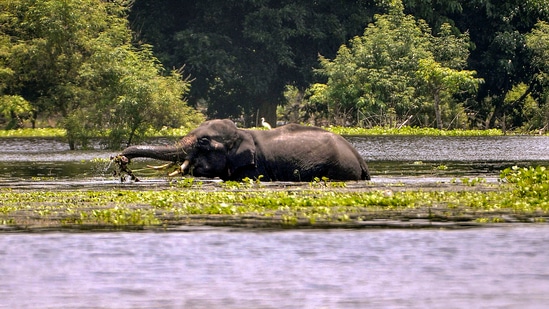Like people, elephants call each other by name

And anthropoexceptionalism takes another tumble
ONE ROLE of science, history suggests, is to wipe that smug grin off humanity’s face. It has moved Earth from the centre of the universe and relocated it in an astronomical backwater. It has downgraded Homo sapiens from being the pinnacle of God’s creation to just another species shaped by Darwinian evolution. And it has constantly chipped away at the uniqueness of the intelligence and communication skills by which many people mark their difference from other beasts.

The latest example of this erosion, described this week by Michael Pardo and his colleagues in a paper in Nature Ecology and Evolution, concerns elephants. These creatures, they reckon, use something equivalent to the arbitrary names human beings invent for each other. Though bottlenose dolphins, which have individual “signature” whistles that they use to identify themselves, may copy others’ whistles when communicating with them, and orange-fronted parakeets likewise echo others’ squawks, elephants are not, according to Dr Pardo, simply adopting as identifiers sounds routinely made by the animal being addressed.
Dr Pardo, who is based at Colorado State University, looked at two long-studied groups of Kenyan elephants—those in Samburu, which have been scrutinised by Iain Douglas-Hamilton and his team since 1997, and those in Amboseli, where scrutiny began in 1972 under Cynthia Moss. Their studies, and earlier ones by Dr Douglas-Hamilton in Tanzania and Uganda, have been crucial to showing that elephants are among the most intelligent animals. Indeed, both Dr Douglas-Hamilton and Dr Moss are co-authors of Dr Pardo’s paper.
The “names” the paper describes are not, it must be conceded, obviously distinctive in the way that human names or dolphin whistles are. They are, rather, hidden in the details of the low-frequency rumbles that form an important part of elephant communication. These rumbling calls, which can cause ground vibrations several kilometres away, are used to keep in touch with group members who are out of sight. They are also made when individuals greet others and are regularly directed by females towards young in the matriarchal groups that are the building blocks of elephant society.
Using historical recordings from Amboseli and specially collected ones from Samburu, Dr Pardo and his colleagues analysed thousands of such calls, alongside information on who made them and who they were apparently directed towards. They then put them through a machine-learning protocol that chewed them up and attempted to identify patterns.
As with dolphin whistles, it has long been known that elephant rumbles are individually recognisable. One thing to establish, therefore, was whether, when communicating with another elephant, the caller was mimicking the recipient. The software suggested this was not the case. It was, however, the case that calls were receiver-specific. This showed up in several ways. First, for a given caller, the receiver could be predicted from the sonic spectrum of its rumble. Second, rumbles directed by a particular caller to a particular recipient were more similar to each other than those made by that caller to other recipients. Third, recipients responded more strongly to playbacks of calls originally directed towards them than to those originally intended for another animal.
On top of this, rumbles directed by different callers towards the same recipient were more similar to each other than to other calls within the data set, suggesting that everyone uses the same name for a given recipient. All of which adds to the evidence that elephant intelligence does indeed parallel the human sort in many ways—and makes their slaughter by humans, which threatens many of their populations, even more horrifying.
Curious about the world? To enjoy our mind-expanding science coverage, sign up to Simply Science, our weekly subscriber-only newsletter.
© 2023, The Economist Newspaper Limited. All rights reserved. From The Economist, published under licence. The original content can be found on www.economist.com





